class: center, top, title-slide .title[ # The Promise and Perils of the Sharing Economy ] .subtitle[ ## The Impact of Airbnb Lettings on Crime ] .author[ ### Charles C. Lanfear<br>David S. Kirk ] .date[ ### 26 June 2025 ] ---  ??? The paper I'll be talking about today was published back in November in *Criminology* after a lengthy review process. It is a big paper, so I'll be breezing through it quickly. If you'd like to dig into the details, it is open access, so look it up. --- # The Growth of Airbnb .image-90[ 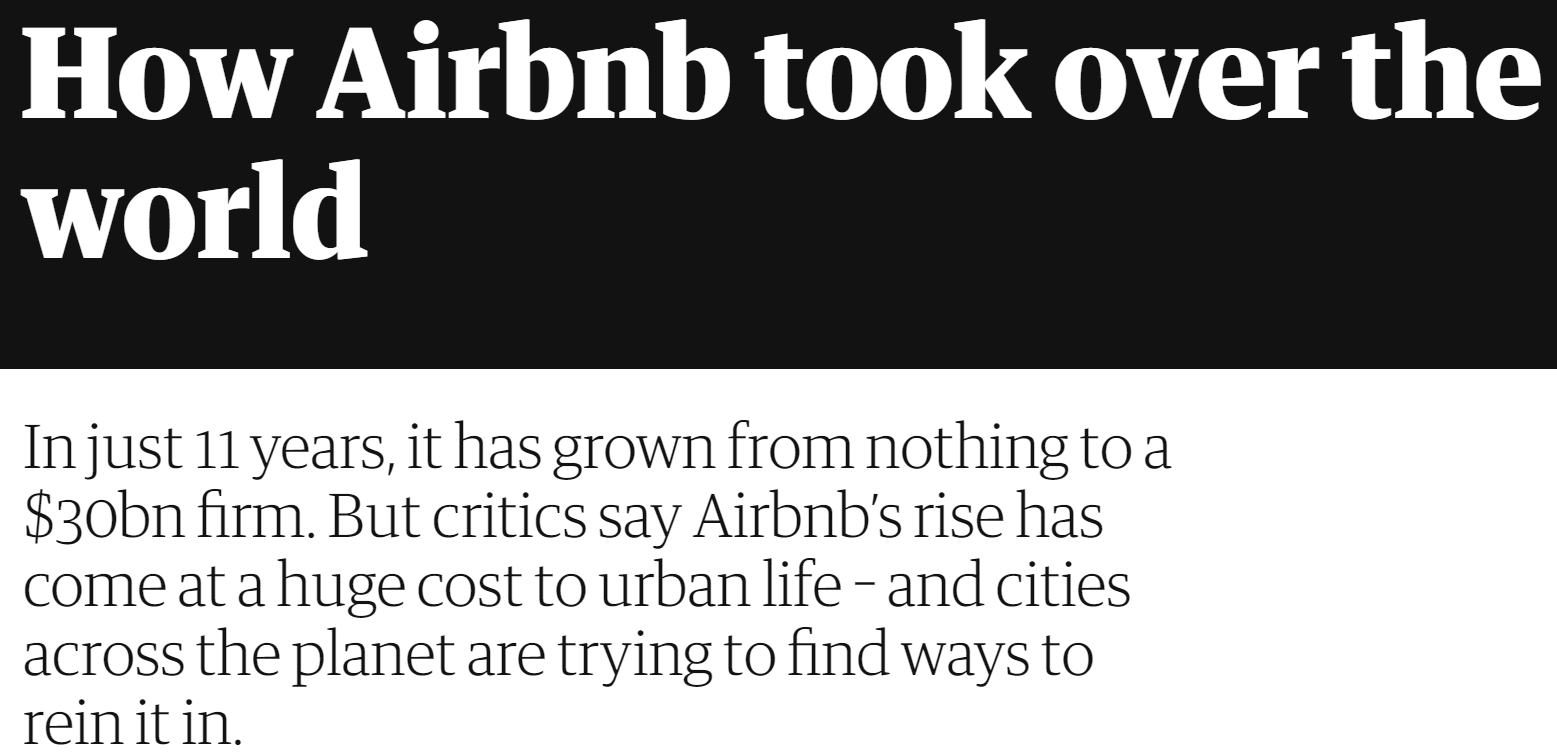 ] .footnote[Source: [Sherwood (2019) *The Guardian*](https://www.theguardian.com/technology/2019/may/05/airbnb-homelessness-renting-housing-accommodation-social-policy-cities-travel-leisure)] ??? Airbnb has grown explosively since its founding in 2008. I expect some or most of you have either stayed in or operated one, and everyone is at least aware of Airbnb as an alternative to conventional hotels. News and social media are filled with concerns that this growth of short-term rentals is now having harmful impacts on communities throughout the world. --- # Housing Markets Barron et al. (2020, p. 45): > To summarize the state of the literature on home-sharing, research (including this paper) has found that **home-sharing (1) raises local rental rates** by causing a reallocation of the housing stock, (2) **raises house prices** through both the capitalization of rents and the increased ability to use excess capacity... ??? The most well-recognized effects are on housing markets, with many studies finding short-term renting reduces the housing supply and drives prices up for both renters and buyers. This occurs because property owners find it more profitable to operate an Airbnb than offer conventional rentals. This profitability has lead some Airbnb operators to purchase additional homes---sometimes dozens---to operate full-time Airbnbs. --- # Anti-Social Behaviour .image-90[  ] .footnote[Source: [Lazzaro (2017) *The Observer*](https://observer.com/2017/03/airbnb-nda-damage-in-london-after-drug-party/)] ??? Short-term rentals may also contribute to disorder and anti-social behaviour. While Airbnb claims these incidents are exceedingly rare, news media abounds with stories---like the one pictured---of nightmare Airbnb guests destroying apartments and parties getting out of hand. We've heard some concerns from police about this as well. We've also heard some concerns about use of Airbnbs in county lines activity, which we can't examine with our data. --- # Destabilization .image-90[ 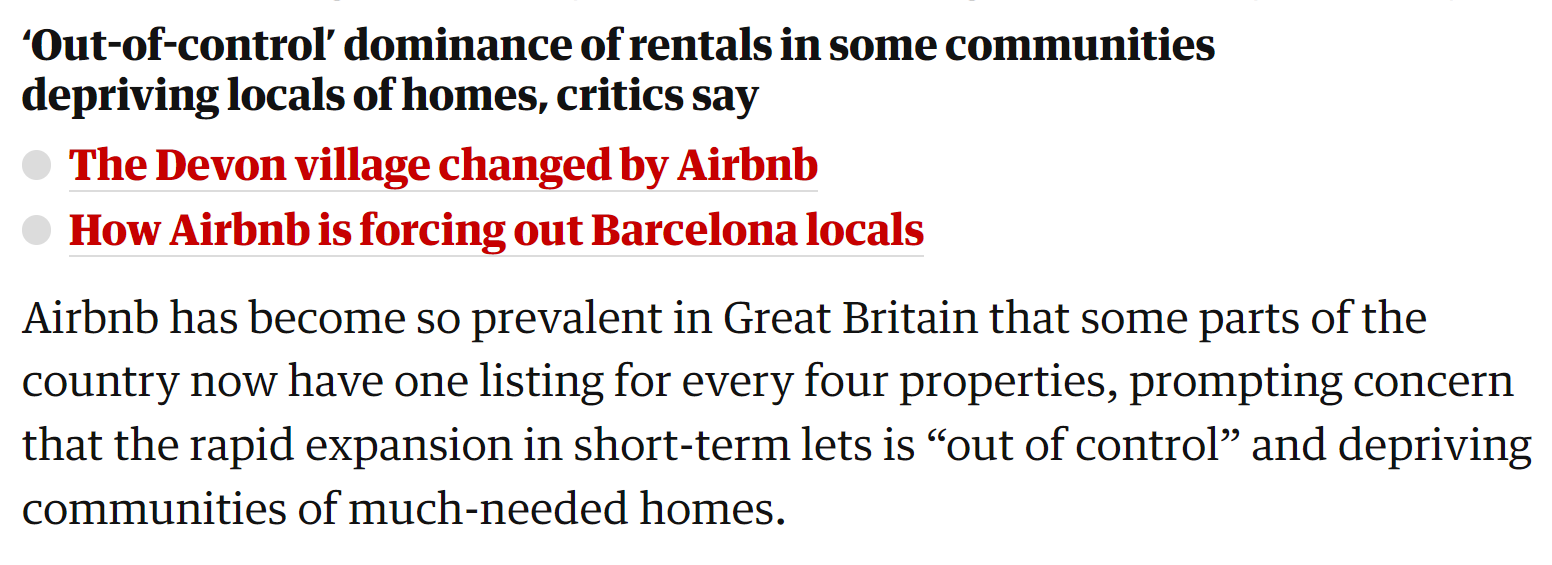 ] .footnote[Source: [Kommenda et al. (2020) *The Guardian*](https://www.theguardian.com/technology/2020/feb/20/revealed-the-areas-in-the-uk-with-one-airbnb-for-every-four-homes)] ??? In some markets, like London, Airbnb growth has become extreme: there are neighborhoods where a quarter or more of housing units are dedicated Airbnb properties We actually estimate as high as 30% in one LSOA in Soho in one quarter. There are concerns that this concentration is destabilizing communities and changing their character as residents are increasingly transient and anonymous --- class: inverse background-image: linear-gradient(to right, rgba(0, 0, 0, .6), rgba(0, 0, 0, .6)), url("img/london_street.jpg") background-size: cover # Criminological Theory ## and Airbnb ??? Based on all that, criminological theory gives us reasons to expect that the proliferation of Airbnbs will increase crime rates We focus on two theories in this paper --- # Routine Activity Theory  * A crime is the result of a criminal .bam[opportunity] * Anything that creates opportunities will increase crime rates * This occurs *rapidly* ??? The first is routine activity theory. Routine activity theory describes crime as the result of opportunities: convergences of likely offenders and suitable targets in the absence of capable guardians. This is a fast effect: When the number of opportunities increases, crime increases immediately. Airbnb properties may contribute to opportunities in a number of ways --- # Airbnb and Routine Activity * Guests as *likely offenders* * More prone to anti-social behaviour -- * Guests as *suitable targets* * Often away from residence (e.g., assault, robbery) * Less aware of and averse to risky situations * Recognizable as high-value targets -- * Guests as *incapable guardians* * Less attached to neighborhood * Unfamiliar with residents and local norms * Often away from residence (e.g., burglary) -- .centernote[These should be stronger for *entire properties* than *spare rooms*.] ??? In spare rooms, you still have permanent residents involved in monitoring, including of the guest. --- # Social Disorganization  * Strong neighborhood institutions reduce crime by promoting .bam[social control] * Destabilizing social structures increases crime by reducing social control * This usually occurs *slowly* ??? The second theory is social disorganization. Social disorganization is a macro-theory of social control that says that sociodemographic advantage and stability promote social control capacity. This capacity promotes both direct intervention and calling the police and is often operationalized using collective efficacy as we do in the paper Collective efficacy consists of shared expectations that residents will intervene against disorder and crime in the context of social cohesion and trust. This social control capacity influences criminal opportunity---mainly through guardianship---and tends to be fairly stable over time Based on social disorganization, we expect Airbnb to increase crime primarily by inducing residential instability --- ## Airbnb and Social Disorganization Entire properties *replace* longer-term residents with very short-term ones * Reduces attachment to neighbourhood * Inhibits social network formation * Weakens institutions -- Spare rooms only *add* short-term residents * Less disruptive * May promote stability with additional income -- .centernote[Effects should be stronger for *entire properties* than *spare rooms*.] --- # Causal Model We encode these theories into a causal model .image-280[ <!-- --> ] .pull-left[ * **A**irbnbs * **C**rime ] .pull-right[ * **O**pportunity * **S**ocial control capacity * **U**nobservables (time stable) ] ??? It looks complicated, but the paths just depict the same relationships I've covered, for two time periods: Airbnbs increase crime via opportunity in short term and via social control in long term The circles indicate variables we can't directly observe, in this case opportunity and social control which mediate (that is serve as mechanisms) for the effect of Airbnb on crime There are also some unobserved characteristics of neighborhoods related to crime and Airbnbs, like other land uses, that could confound all of our estimates... but we argue the key ones are somewhat stable over short periods. --- # Hypotheses 1. Airbnb properties are positively related to crime 2. Entire properties will be more strongly related to crime than rooms 3. Airbnb activity will be negatively related to collective efficacy 4. The association between Airbnb activity and crime is partly explained by collective efficacy --- class: inverse background-image: linear-gradient(to right, rgba(0, 0, 0, .6), rgba(0, 0, 0, .6)), url("img/london.jpg") background-size: cover # Airbnb in London --- # Airbnb in London * One of the most popular Airbnb markets * \> 100,000 listings in a year<sup>1</sup> * 20% of surveyed households hosted in past year<sup>2</sup> * \>= 10% of dwellings are Airbnbs in some districts<sup>3</sup> .footnote[ [1] Temperton 2020; [2] MHCLH 2019; [3] Kommenda et al., 2020 ] -- * Policies promote Airbnb activity * Deregulation Act 2015 * Permits 90 days of main residence renting per year * 2016 "Rent a Room" tax allowance * Increased from £4,250 to £7,500 --- # Data .pull-left[ .bam[Active Airbnb properties] from *AirDNA* via CDRC * Nov 2014 - May 2018 * Property-month observations * Property type * Geolocation ] .pull-right[ ] --- count: false # Data .pull-left[ .bam[Active Airbnb properties] from *AirDNA* via CDRC * Nov 2014 - May 2018 * Property-month observations * Property type * Geolocation Police-recorded .bam[crime] from *data.london.gov.uk* and *data.police.uk* * 6 crime types * Mix of LSOA counts and approximate geolocation ] ??? Robbery, burglary, theft, antisocial behavior, violence, and specifically violence resulting in bodily harm --- count: false # Data .pull-left[ .bam[Active Airbnb properties] from *AirDNA* via CDRC * Nov 2014 - May 2018 * Property-month observations * Property type * Geolocation Police-recorded .bam[crime] from *data.london.gov.uk* and *data.police.uk* * 6 crime types * Mix of LSOA counts and approximate geolocation ] .pull-right[ <br>Public Attitudes Survey (PAS) * .bam[Collective efficacy] * N = 48,093 ] ??? The PAS asks 8 questions on cohesion and trust and expectations for social control that have been used to measure collective efficacy in a number of past papers. The survey is administered to a representative sample 100 respondents in each of the 32 boroughs every quarter, giving 48,000 valid responses over our analysis period. I'll get into it more later, but this provides reliable estimates of efficacy down to the Ward but not LSOA level. --- count: false # Data .pull-left[ .bam[Active Airbnb properties] from *AirDNA* via CDRC * Nov 2014 - May 2018 * Property-month observations * Property type * Geolocation Police-recorded .bam[crime] from *data.london.gov.uk* and *data.police.uk* * 6 crime types * Mix of LSOA counts and approximate geolocation ] .pull-right[ <br>Public Attitudes Survey (PAS) * .bam[Collective efficacy] * N = 48,093 In paper but not shown today: * Perceived crime * Perceived police patrols * Airbnb usage * Policy instruments * Premier League games * Property prices * Police stops ] --- 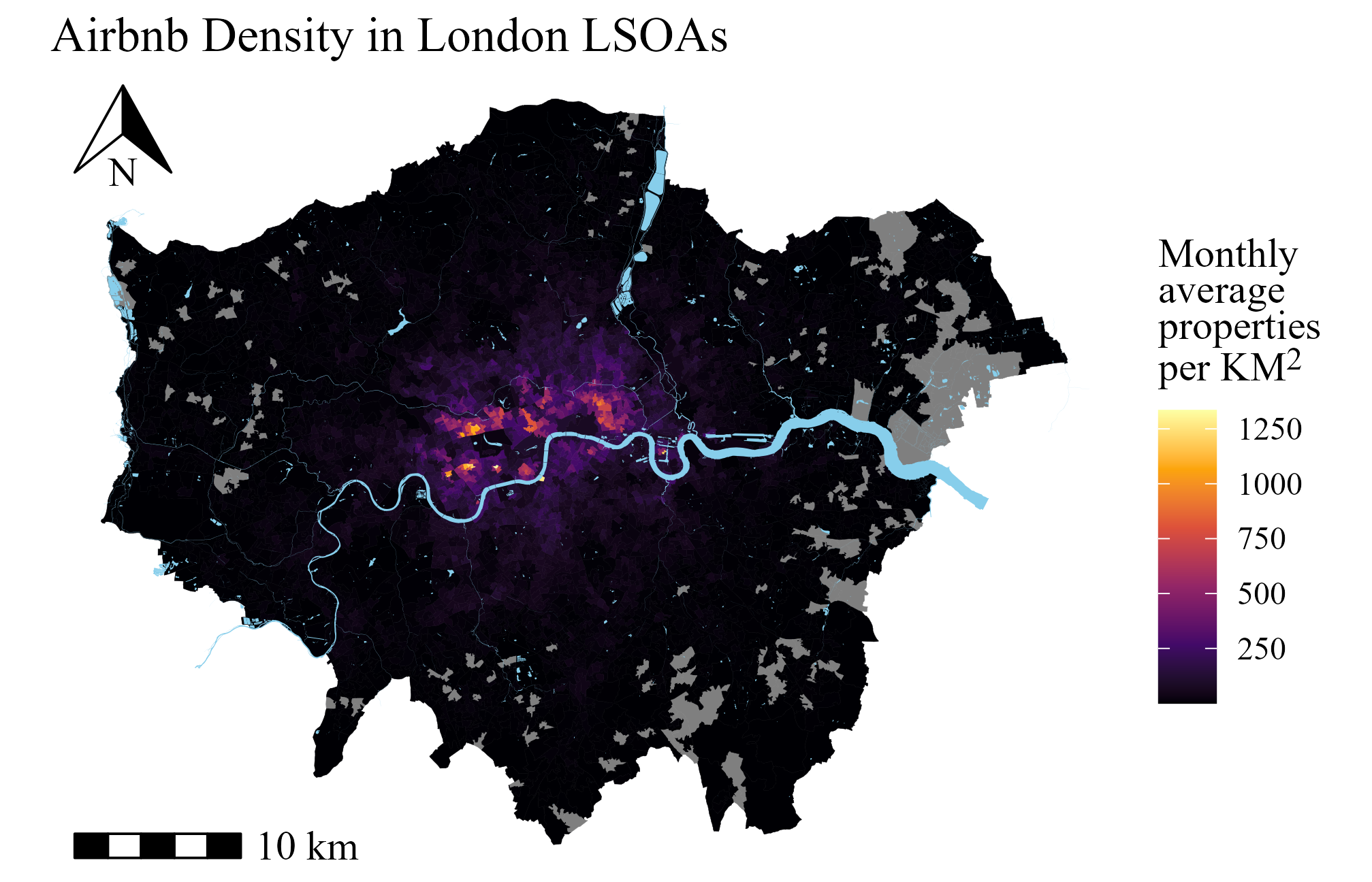 .footnote[Average 39,000 active per month with 4.5 million estimated guests across study period] ??? Highly concentrated around the center of the city and tourist attractions ---  ??? Note that the residential population is much less concentrated around the city centre --- class: inverse background-image: linear-gradient(to right, rgba(0, 0, 0, .6), rgba(0, 0, 0, .6)), url("img/house_party.jpg") background-size: cover # Airbnb and Crime --- # The Model Again .image-280[ <!-- --> ] .pull-left[ * **A**irbnbs * **C**rime ] .pull-right[ * **O**pportunity * **S**ocial control capacity * **U**nobservables (time stable) ] .centernote[*If concerned only with A → C, we can ignore mediators*] ??? Here's the model again. For the main analysis, we're only interested in total effects of Airbnb on crime, so we can ignore the unobserved mediators to get a simpler model. --- count: false # Simplified Model .image-280[ <!-- --> ] .pull-left[ * **A**irbnbs * **C**rime ] .pull-right[ * ~~**O**pportunity~~ * ~~**S**ocial control capacity~~ * **U**nobservables (time stable) ] .centernote[*This is a cross-lagged panel model*] ??? This simpler model is a type of cross-lagged panel model, specifically one with contemporaneous effects and confounding unobservables. --- # Estimator: ML-SEM Maximum Likelihood Fixed Effects Cross-Lagged Panel Model (ML-SEM)<sup>1</sup> * Asymptotically equivalent to Arellano-Bond<sup>2</sup> * Contemporaneous and lagged effects * Autoregressive parameter * Predetermined regressors * Addresses time-stable confounders .pull-right30[ .footnote[ [1] Allison et al. (2017)<br> [2] Arellano & Bond (1991) ] ] ??? I have graphical depictions of the estimator specification that I can bring up in Q&A if anyone wants more detail. -- * Practical differences * Better finite sample performance * Relaxes instrument assumptions * Infeasible with large `\(T\)` * Gets angry about heavy skew -- * `\(N\)` = 4835 LSOAs, `\(T\)` = 13 quarters ??? The properties of the estimator lead us to aggregate the data to quarters Results are unchanged using a monthly Arellano-Bond or two-way fixed effects Poisson. --- .image-tall[ 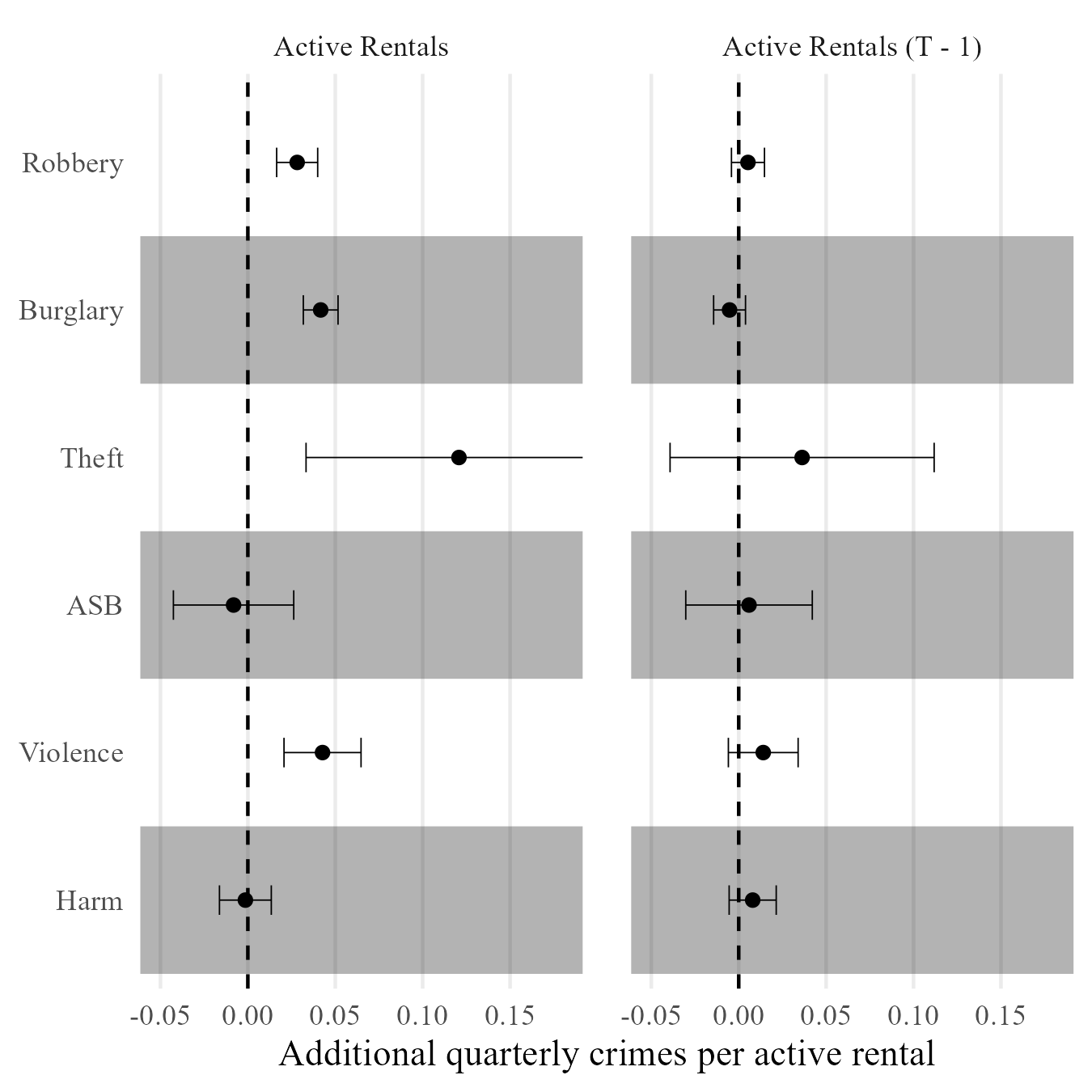 ] ??? Our first hypothesis was that Airbnbs impact crime. Here we see the estimated number of additional crimes we'd see per active Airbnb in the present quarter on the left and per Airbnb active in the last quarter on the right. The left shows modest positive associations with Robbery, Burglary, Theft, and Violence in the same time period but no appreciable lagged effect. --- # Property Types Both theories suggest effects should be concentrated in *entire homes and apartments* ??? Our next hypothesis was that criminogenic effects should be more prominent for entire properties, because they reduce guardianship, increase suitability, and destabilize communities more than spare rooms -- Respecify model with disaggregated Airbnb measures: * Entire Homes and Apartments * Private Rooms * Shared Rooms --- .image-tall[ 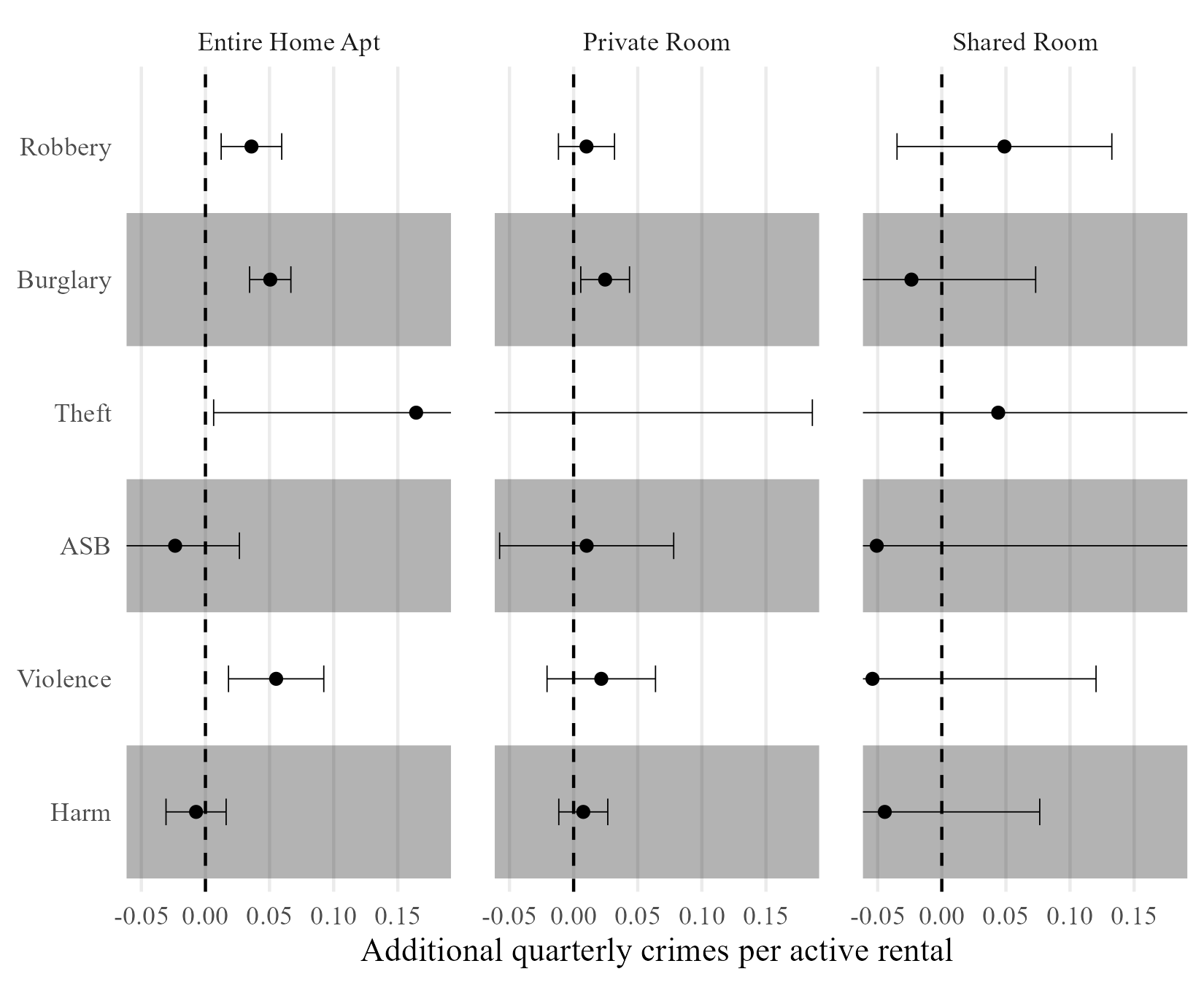 ] ??? Here is the same type of plot again, but now I show only contemporaneous effects because the lagged ones are all near-zero again. As expected, we see the total association is mainly driven by entire properties---though we see a bit of evidence for private rooms and burglary. Shared rooms are rare, so estimates there are very noisy. Anyway, this provides support for our second hypothesis. --- # Summary Per quarter, each additional Airbnb is associated with... * 0.03 robberies * 0.04 burglaries * 0.16 thefts * 0.06 violent offenses ??? Okay, let's talk about these results a bit. We find, per quarter... ... these may seem small in magnitude, but keep in mind many LSOAs have dozens or even hundreds dedicated Airbnb properties. As we say in the paper, "If the volume of active Airbnb rentals increased by 10% in London from 2018 levels, we would expect that the number of robberies would increase by approximately 1,000 per year, a 3.1% increase from the 32,500 robberies recorded in London in 2018" We also find these estimates are quite stable (or robust) across different specifications, including different causal timings, accounting for Premier league games or spatial clustering, and even excluding Zone 1 of London -- Effects driven by entire homes and apartments for rent * Consistent with opportunity as mechanism * Consistent with destabilization as mechanism -- Effects appear to operate only in short-term * Suggests opportunity as mechanism -- .centernote[ *But we can also test collective efficacy as a mechanism* ] --- count: false class: inverse background-image: linear-gradient(to right, rgba(0, 0, 0, .3), rgba(0, 0, 0, .3)), url("img/onion_airbnb.jpg"), linear-gradient(to right, rgba(0, 0, 0, 1), rgba(0, 0, 0, 1)) background-size: 100%, 50%, 100% background-position: center, center, center # Airbnb and Collective Efficacy --- count: false # Yet Again .image-280[ <!-- --> ] .pull-left[ * **A**irbnbs * **C**rime ] .pull-right[ * **O**pportunity * **S**ocial control capacity * **U**nobservables ] -- .centernote[*This time we care about S*] --- count: false # Simplified Again .image-280[ <!-- --> ] .pull-left[ * **A**irbnbs * **C**rime ] .pull-right[ * ~~**O**pportunity~~ * **S**ocial control capacity * **U**nobservables ] -- .centernote[*We need to create a measure of S*] --- # Measuring Collective Efficacy Collective efficacy is a community-level .bam[latent variable] * Survey respondents act as *informants* -- Assume informant responses to collective efficacy indicators are a mix of: * True latent collective efficacy we want to measure * Systematic perceptual error related to demographic background * Non-systematic (random) measurement error -- Validity of measurement rests on .bam[reliability], a function of: * Agreement between informants * **Number of informants in each neighborhood** -- .centernote[*We need to remove measurement error and estimate reliability*] --- count: false ## Multilevel Measurement Model .image-75[  ] ??? What we observe are the indicators at the bottom, which are the product of underlying perceived collective efficacy (plus some measurement error). That perceived collective efficacy is caused by actual neighborhood collective efficacy plus bias related to respondent characteristics (and again, some error). To get the neighborhood measure, we proceed in two stages. --- count: false ## Stage 1 .image-75[  ] .centernote[*Purge random measurement error, obtain individual estimate*] --- count: false ## Stage 2 .image-75[  ] .centernote[*Adjust for demographic composition, obtain neighborhood estimate*] --- # Units of Analysis Given our models, how should we aggregate data? -- ‍Space: * Some theoretical debate over spatial scale of social control * Many respondents needed for reliable measurement -- ‍Time: * Social control effects are slow * Changes in social control capacity may be even slower * Many respondents needed for reliable measurement -- ‍Unit: **Ward half-years** * High collective efficacy reliability: 0.68 * Logged crime outcome to address skew ??? We settled on Ward half-years which give reliability similar to past work using collective efficacy We also ran yearly analyses, which give somewhat stronger collective efficacy and weaker Airbnb effects, but the interpretation is substantively the same. --- .image-tall[ 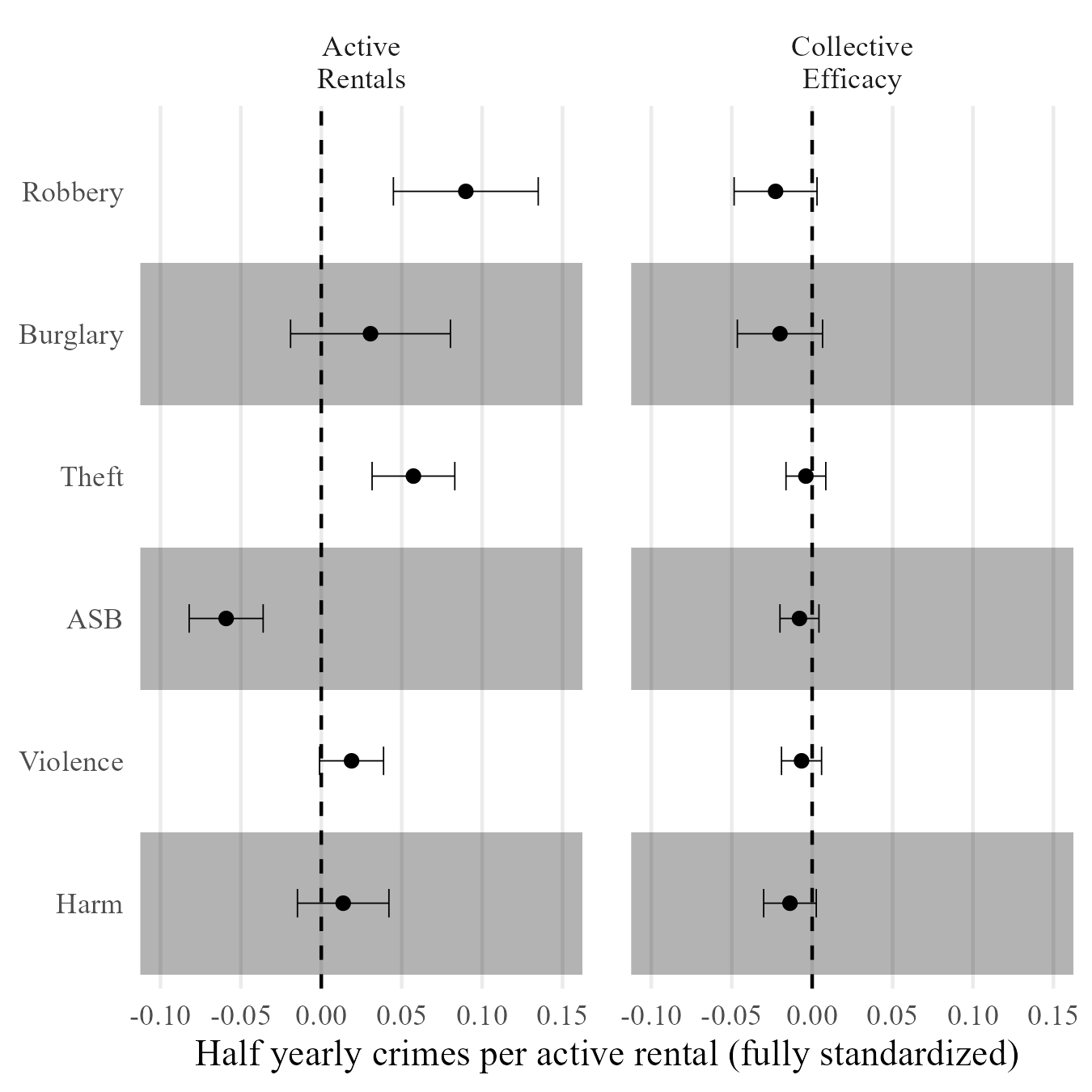 ] ??? This repeats the LSOA plot from before, showing only the contemporaneous associations of Airbnb activity with crime on the left and collective efficacy with crime on the right. On the Airbnb to crime side, the results are a bit weaker but substantively the same as the LSOA quarter models; we see a positive association, and it doesn't go away when accounting for collective efficacy. On the collective efficacy to crime side, there is a weak negative association, which is not statistically significant (though it is stronger and significant in the yearly models). Together this suggests collective efficacy is not explaining the relationship between Airbnbs and crime. --- # Airbnb and Collective Efficacy How is Airbnb activity related to collective efficacy? * Estimate both sides of Airbnb and CE cross-lagged model ??? There's no free lunch: Estimating both sides does not allow clearly distinguishing the direction of a contemporaneous effect, but it works for the lagged effect where we would expect to see effects -- .image-90[ 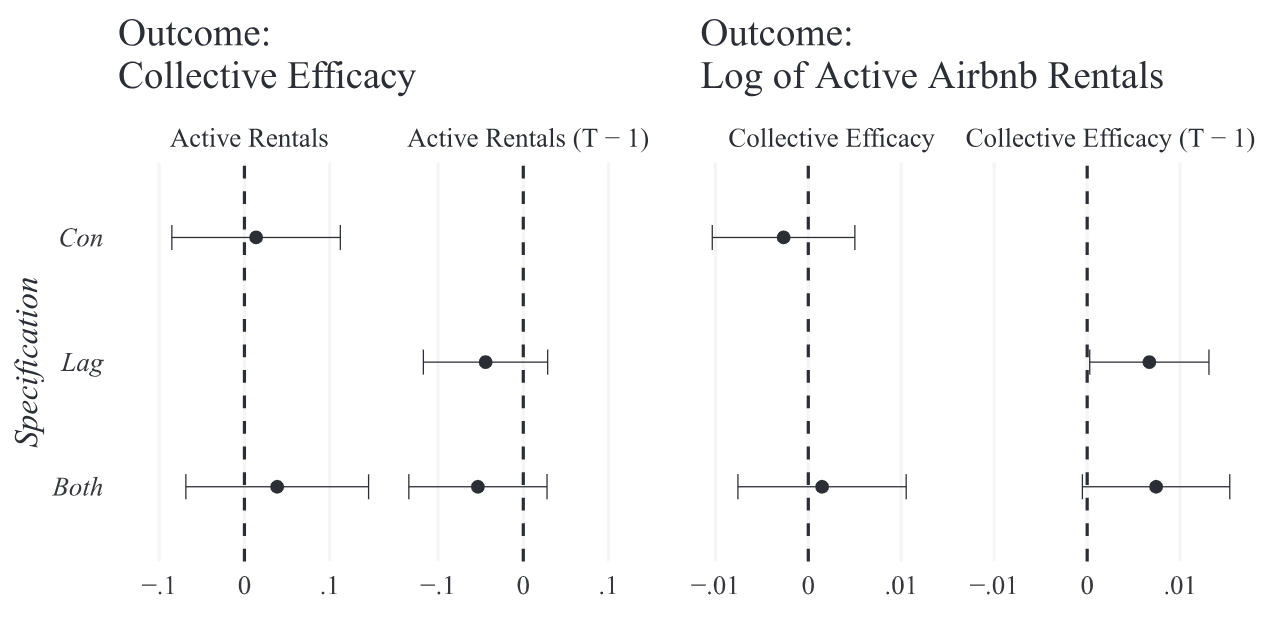 ] ??? Results are noisy but suggest a modest negative feedback loop: More Airbnbs are associated with lower collective efficacy over time, but higher efficacy is associated with more Airbnbs---though this is a tenth as strong as the other direction, as our theoretical model implies. These results are again stronger in yearly models, which probably more accurately match the slow process of neighborhood change. --- # Summary Weak collective efficacy effects * Inconsistent with social disorganization -- Weaker but persistent Airbnb effects * Inconsistent with social disorganization * More consistent with routine activity * Opportunity is contemporaneous and local -- Airbnb activity may reduce collective efficacy over time --- class: inverse background-image: linear-gradient(to right, rgba(0, 0, 0, .6), rgba(0, 0, 0, .6)), url("img/oxford_houses.jpg") background-size: cover # Discussion --- # Implications Private short-term letting is reshaping the urban landscape * Increasing apartment rents and home prices * .bam[Compromising public safety] ??? Let's talk about implications. We already knew Airbnbs are affecting housing markets, and possibly changing the character of neighborhoods. Our results suggest they're also affecting public safety, mainly in terms of instrumental crimes like theft, burglary, and robbery. -- Short-term letting is highly commercialized * Primarily dedicated year-round properties * Dominated by hosts with multiple dedicated properties -- This is an externality problem * Benefits accrue to few property owners * Livability and affordability reduced for all ??? In economic terms, this is an externality problem; costs accrue to people not involved in the market activity that is occurring. -- .centernote[*Policy is needed to address the social costs of short-term letting, in particular from dedicated properties*] --- class: inverse # Q&A # *Thank you!* --- count:false class: inverse # Appendix --- count:false # LSOA Quarter Specification .pull-left60[ .image-100[ <!-- --> ] ] .pull-right30[ Outcome (Ct): * LSOA-quarter crime counts ‍Features: * Airbnb effects: * .electric[Contemporaneous] * .rose[Lagged] * .pine[Fixed effects] * .burgundy[Autoregression] * .cobalt[Predetermined regressors] ] --- count: false # Ward Half-Year Specification .footnote[[1] All covariances hidden for legibility] .pull-left60[ .image-100[ <!-- --> ] ] .pull-right30[ Outcome (Ct): * **Logged** Ward-year crime counts Features: * Airbnb and CE: * .electric[Contemporaneous] * .rose[Lagged] * .pine[Fixed effects] * .burgundy[Autoregression] * Predetermined regressors<sup>1</sup> ] --- count:false # References .small[ Allison, P. D., Williams, R., & Moral-Benito, E. (2017). Maximum Likelihood for Cross-lagged Panel Models with Fixed Effects. Socius: Sociological Research for a Dynamic World, 3, 237802311771057. https://doi.org/10.1177/2378023117710578<br> Arellano, M., & Bond, S. (1991). Some Tests of Specification for Panel Data: Monte Carlo Evidence and an Application to Employment Equations. The Review of Economic Studies, 58(2), 277. https://doi.org/10.2307/2297968<br> Barron, K., Kung, E., & Proserpio, D. (2021). The Effect of Home-Sharing on House Prices and Rents: Evidence from Airbnb. Marketing Science, 40(1), 23–47. https://doi.org/10.1287/mksc.2020.1227<br> Kommenda, N., Pidd, H., & Brooks, L. (2020). Revealed: The areas in the UK with one Airbnb for every four homes. The Guardian.<br> Ministry of Housing, Communities & Local Government (MHCLG). (2019). English housing survey: Private rented sector, 2017-2018. Ministry of Housing, Communities & Local Government.<br> Temperton, J. (2020). Airbnb has devoured London - and here’s the data that proves it. Wired UK. Unsplash photos: [Title slide photo by Andrea Davis](https://unsplash.com/photos/NngNVT74o6s)<br> [House party photo by Jacob Bentzinger](https://unsplash.com/photos/_HXFz-0g9w8)<br> [Oxford houses by Toa Heftiba](https://unsplash.com/photos/nrSzRUWqmoI)<br> [London street by Tomek Baginski](https://unsplash.com/photos/SiGPM-HLYyk)<br> [London aerial photo by Benjamin Davies](https://unsplash.com/photos/Oja2ty_9ZLM) [Story from the Onion](https://www.theonion.com/whole-conversation-wasted-getting-to-know-new-neighbors-1849022517) ]